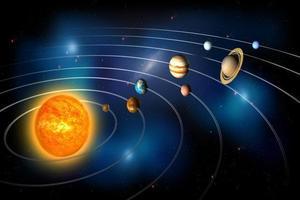12893243
UNIT 6.4 STARS AND PLANETS
Descrição
Resumo de Recurso
| Questão | Responda |
| List the planets of the solar system, in order moving away from the sun. | Mercury - My Venus - Very Earth - Easy Mars - Method Jupiter - Just Saturn - Speeds Uranus - Up Neptune - Naming |
| What is an asteroid? | Asteroids are lumps of rock which are in orbit around the Sun but are too small to be called planets. The asteroid belt is located between Mars and Jupiter and contains a number of dwarf planets. Ceres is largest of these with a diameter of 587 miles. |
|
What is a comet?
Image:
Comet (binary/octet-stream)
|
Comets are lumps of ice and dust which are in a highly elliptical orbit around the Sun. They travel very far out of our solar system and take a number of years to return closer to the Sun. Halley’s Comet is one of the most famous, it has an orbital period of about 75 years. |
|
What is a moon?
Image:
Moon (binary/octet-stream)
|
A moon is natural satellite or body that orbits a planet or minor planet. Moons (also called satellites) come in many shapes, sizes and types. |
| What is an astronomical unit? | 1 Astronomical Unit (1 AU) is the mean distance from the centre of the Earth to the centre of the Sun. |
| What is a light year? | 1 light year (1l-y) is the DISTANCE light travels in one year. Light from our nearest star, Alpha Centauri, takes 4.4 years to reach us. Therefore the DISTANCE to Alpha Centauri is 4.4 light years. |
| List the life stages for a star with a mass greater than 8 solar masses. | -Protostar - Blue star - Red super giant - Supernova explosion - Neutron star or Black hole (for stars greater than 25 solar masses) |
| Describe the forces within a star during the stable stage of it's life cycle. | The inward force of gravity on the star is balanced (equal) by outward forces of gas pressure and radiation pressure. (Our Sun is at this stable phase in its life.) |
| Describe how our sun will transition into a red giant star in around 6.2 billion years from now. | Once our sun has used all of it's hydrogen fuel, nuclear fusion will cease and the temperature of the core will decrease. The force of gravity inwards will now be greater than the gas pressure and radiation pressure outwards, so the suns's core will shrink in size. This gravitational collapse will cause the core temperature, gas pressure and radiation pressure to increase again until the fusion of helium begins. Helium fusion is much hotter than hydrogen fusion, so the far higher temperature, gas pressure and radiation pressure will cause the sun’s outer layers to expand to form a red giant. |
| How do scientists believe the solar system was formed? | Scientists believe a cloud of gas and dust in space was disturbed by the dying explosion (supernova) of a nearby star. This explosion caused the cloud to collapse and begin to spin, growing hotter and denser at it's centre. Due to gravity, small particles began to stick together and form bigger 'clumps.' Some clumps got bigger, as more particles and small clumps stuck to them, eventually forming planets or moons . Only rocky material could survive the great heat near the centre of the cloud where planets like Earth formed. Icy matter settled in the outer regions of the disk along with rocky material, where the giant planets like Jupiter formed. Eventually, due to gravity, the cloud's centre became so hot and dense that it became a star, the Sun. |
Quer criar seus próprios Flashcards gratuitos com GoConqr? Saiba mais.

